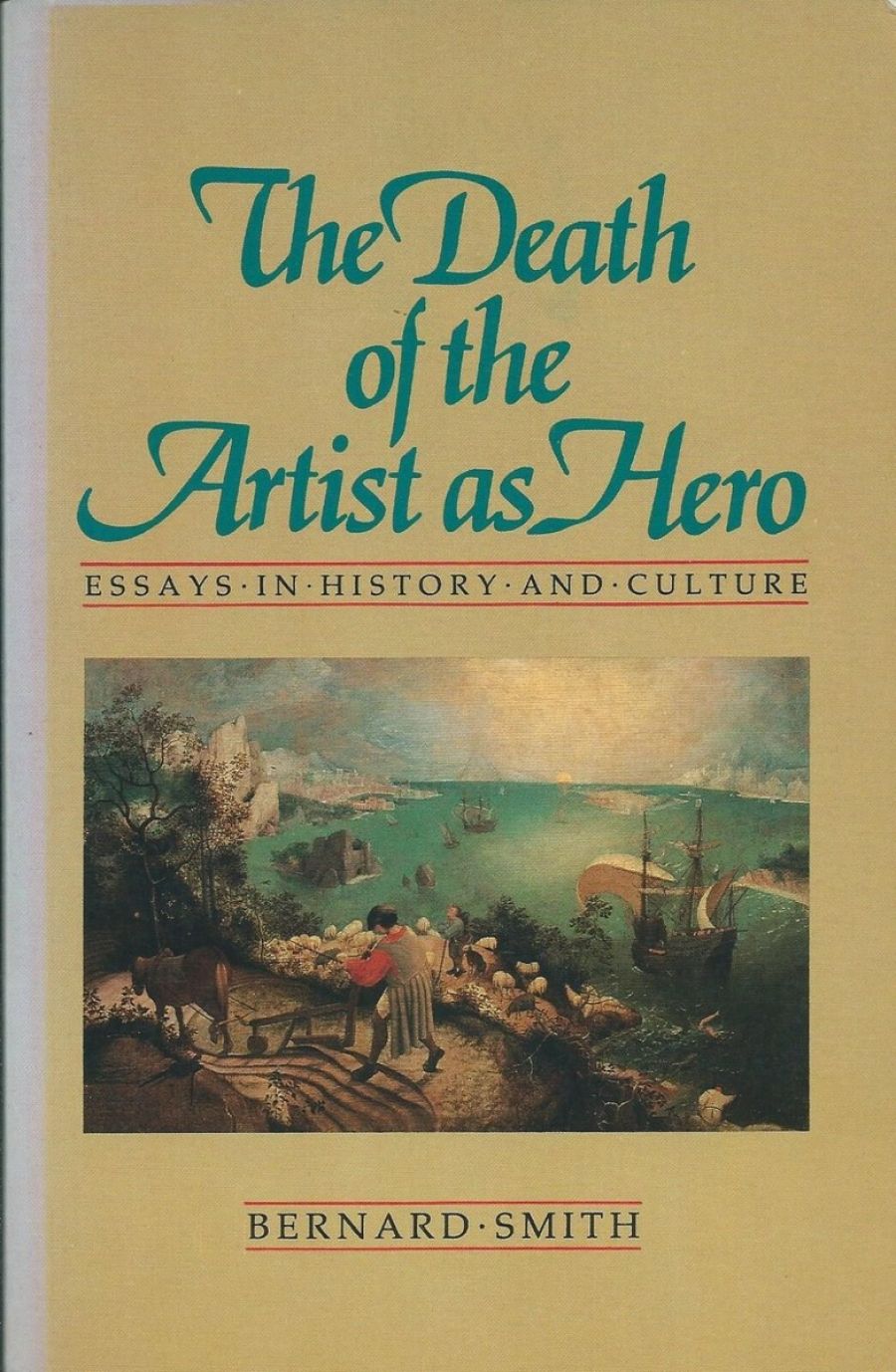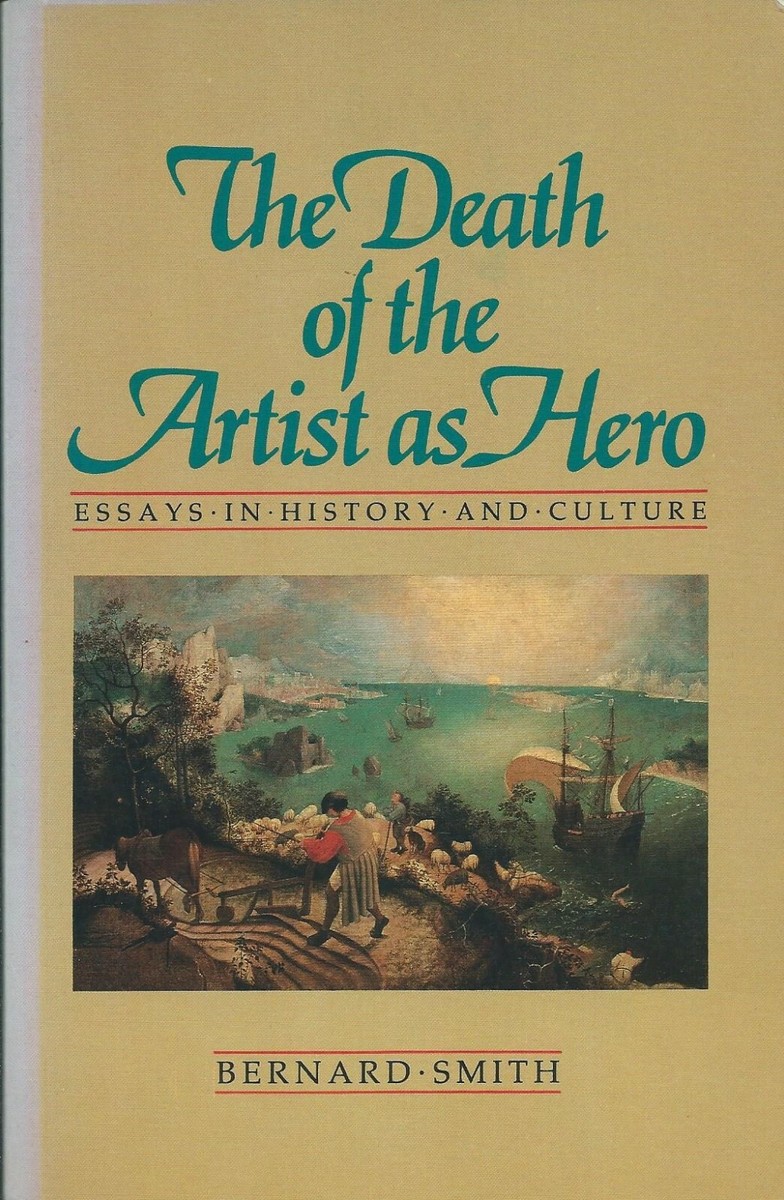
- Free Article: No
- Contents Category: Essay Collection
- Review Article: Yes
- Article Title: Art, a dialogue with life
- Online Only: No
- Custom Highlight Text:
It is nearly thirty years since Bernard Smith’s classic European Vision and the South Pacific opened the eyes of regional historians to anew range of perceptions: his latest book continues our education in a manner always informative and stimulating and very often most entertaining.
- Book 1 Title: The Death of the Artist as Hero
- Book 1 Subtitle: Essays in History and Culture
- Book 1 Biblio: Oxford University Press, $19.95 pb, 331 pp
- Book 1 Cover Small (400 x 600):

- Book 1 Cover (800 x 1200):

Perhaps with a sentence from the final paragraph of ‘Is there a Radical Tradition in Australian Art?’ – ‘art is always a dialogue with life, and life is where you are.’ (p. 240) The whole book is an extended gloss on this dictum, which may seem a truism but also seems too often forgotten by the more recondite and rarefied critics from Acadame, or exploited in a vulgar manner by the trendy and the market-oriented. Smith belongs to neither camp; he is above them, but far from an Olympian aloofness, for there is a robust common sense in the more ‘operative’ essays, such as those on the socially educative roles of art museums.
Smith is much concerned with the problems of elitism, which he spells, correctly, with an accent – perhaps a rather elitist thing to do in this age and place. This is a most baffling and perennial problem, and I am not quite easy with his summarising dictum that ‘if your object is excellence, you begin with a broad base: elitism fails because it insists upon a narrow base; its apex fails to reach the limits of the possible.’ (p. 7) Does it, always? One can hardly acquit the Renaissance or the slavery-based Greeks of elitism, nor deny them excellence; there may be a way around this, by appealing to democracy within the elite. but even then, how do we know what were or are the limits of the possible? or that given the techniques available in a given situation, these limits were not reached? These queries raised, however, I have nothing but admiration lor the really brilliant historical analysis of the question in the title essay.
In general Smith’s discussion of innovation and abstract art is excellently balanced: he has no patience with those who would wipe the slate clean of pre-existing styles and is tightly suspicions of either-or dichotomies. pointing out that there is an abstract element in all paintings (p. 21.5) He has a very acute discussion of the degree to which the various arts are susceptible of abstraction: music, architecture, painting, sculpture. poetry, in that order. (pp. 181-2) For music this priority seems obvious, lor architecture perhaps a little odd. though subjectively he makes out an interesting case.
I am rather doubtful whether ‘to push sculpture to the full limit of abstraction is to weaken it ... It is not necessary to reject the human form in older to create good sculpture.’ (p. 183)
The first part of this statement might be regarded as a matter where de gustibus non disputandum applies, a matter of taste; the second is a truism which does not follow from the first, which for the argument it should – as light lapse in Smith’s generally very tightly argued and indeed rigorous analysis.
Much of the book is couched in Marxist terms, but in those of a humanist Marxism, ‘curious, questing, not dogmatic’ (p. 115) like that of Jack Lindsay, to whose many-sided genius and love of life Smith pays splendid tribute; neither of them is likely to escape ‘difficulties with the dogmatic Left and the geriatric Right.’ (p. 133) The analysis in ‘Marx and Aesthetic Value’ – one of five hitherto unpublished pieces – is particularly closely argued. So is the last item in the collection. ‘On Cultural Convergence’, also new and a most apposite tract for the times. (p. 289-302)
This has some hard-hitting criticism, some welcomes and some warnings. Smith calls for a convergence of cultures, carefully distinguishing this from a mere up-dated version of assimilation: convergence is a meeting of equals, assimilation ‘an act of ethnic cannibalism.’ And convergence also contains the possibility of divergence, brandling out into new and fruitful combinations. Here is where the salutary warnings come in: while guilt is not a reprehensible motive for action – it is a mode of awareness of social responsibility – it carries the risk of paternalism and patronage, symbolic gestures, in short tokenism. But there is another danger: the idealisation of a primitive culture that never was’ and the ‘deplor[ing] of any observable changes as evidence of corrupting influence.’ (There does indeed seem a tendency to resurrect the Noble Savage in the person of the Australian Aborigine; a disservice which would condemn a people to becoming a static model which we do not propose to follow in our own lives.) But after all, change is the law of life.
Here Smith speaks not with an easy compassion and unrealistic synthetic admiration but with real feeling and common sense. He takes issue with that tribal solipsism voiced, sometimes stridently, in the Pacific which claims that only the insider can have anything worthwhile to say; he goes so far as to write that ‘the quality of a culture is best judged, in the long run, by critics separated from it both in time and space.’ (p. 217) At the very minimum there has to be some standard of comparison, not a simply self-regarding view, so that a dialectic synthesis may be gradually created. I think this is in accordance with Smith’s defence of the creative use by non-Aborigines of aboriginal art, and vice versa. In the last resort the whole process of human culture seems to me a gigantic complex of cross-fertilisation.
Smith’s width and depth of reading need no advertisement; he writes with lucidity and urbanity, with wisdom as well as wit; his epigrams are not of the kind which dazzle for a moment but leave one basically unaffected, they repay pondering upon. His deep feeling for the dignity of art and its profound relevance to social life make this book a record of a career honourably devoted to the assertion, the defence and the enhancement of these values.


Comments powered by CComment